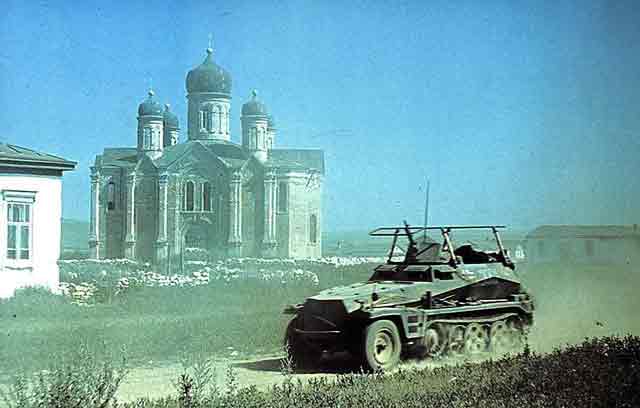Tuesday 7 October 1941
 |
| A German Sdkfz 250 passes by a Russian Eastern Orthodox Church. |
 |
| "Mrs. Armitage (left) and Miss Betty Leverton, of the London Auxiliary Ambulance Service, leaving after being decorated by the King at a recent Investiture at Buckingham Palace. Both received the British Empire Medal." 7 October 1941. © IWM (10556138) |
Religion is the opium of the people: this saying of Marx is the cornerstone of the entire ideology of Marxism about religion. All modern religions and churches, all and of every kind of religious organizations are always considered by Marxism as the organs of bourgeois reaction, used for the protection of the exploitation and the stupefaction of the working class.Given this attitude toward religion, Stalin must be very worried to go to the extreme of allowing it again.
 |
| A Soviet soldier kissing his Cross just before the Battle of Kursk in July 1943. |
 |
| "A wounded German prisoner, a walking case, coming ashore from the hospital ship." This photo was taken on 7 October. It shows the end of an attempted prisoner exchange, where wounded German POWs were to be exchanged for similar British ones at New Haven and Dieppe. However, Hitler changed his mind at the last minute and blocked the exchange. The German POWs on board hospital ships HMS Dinard and St. Julian were disembarked back in England, as shown in this photo and sent back to their camps or hospitals. © IWM (A 5687). |
 |
| U-190 was laid down on 7 October 1941. This is a photo taken of U-190 after its surrender on 14 May 1941 at Bay Bulls, Newfoundland. Note the numerous late-war enhancements, including the raised snorkel by the man which has the round Wanz radar warning receiver at the top. Behind it on the bridge is a raised periscope and a longwave antenna (starboard forward corner). The "slimming" of the deck in the foreground is not the end of the submarine but rather a cut-away upper deck which it was felt would reduce time to submerge (John Taylor, RCNVR of Hamilton, Ontario, via Bill Taylor and Uboatarchive.net). |
October 1941
October 1, 1941: Germans and Finns Advance in USSR
October 2, 1941: Operation Typhoon Broadens
October 3, 1941: Air Battles Near Moscow
October 4, 1941: Stalin Contemplates Defeat
October 5, 1941: Hoth Goes South
October 6, 1941: First Snowfall After Dark
October 7, 1941: Stalin Gets Religion
October 8, 1941: FDR Promises Stalin Aid
October 9, 1941: FDR Orders Atomic Bomb Research
October 10, 1941: Reichenau's Severity Order
October 11, 1941: Tank Panic in Moscow
October 12, 1941: Spanish Blue Division at the Front
October 13, 1941: Attack on Moscow
October 14, 1941: Germans Take Kalinin
October 15, 1941: Soviets Evacuate Odessa
October 16, 1941: Romanians Occupy Odessa
October 17, 1941: U-568 Torpedoes USS Kearny
October 18, 1941: Tojo Takes Tokyo
October 19, 1941: Germans Take Mozhaysk
October 20, 1941: Germans Attack Toward Tikhvin
October 21, 1941: Rasputitsa Hits Russia
October 22, 1941: Germans Into Moscow's Second Defensive Line
October 23, 1941: The Odessa Massacre
October 24, 1941: Guderian's Desperate Drive North
October 25, 1941: FDR Warns Hitler About Massacres
October 26, 1941: Guderian Drives Toward Tula
October 27, 1941: Manstein Busts Loose
October 28, 1941: Soviet Executions
October 29, 1941: Guderian Reaches Tula
October 30, 1941: Guderian Stopped at Tula
October 31, 1941: USS Reuben James Sunk
2020
No comments:
Post a Comment